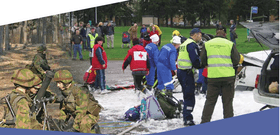Finnish Red Cross
 | |
| International nongovernmental organization | |
| Industry | Well-being |
| Founded | May 7, 1877 |
| Headquarters | Helsinki, Finland |
Key people | Mr Pertti Torstila, Ms Kristiina Kumpula |
| Products | Humanitarian aid |
Number of employees | 1,168 (2006), 95,000 members & 45,000 active volunteers |
| Website |
www |
The Finnish Red Cross (FRC, Finnish: Suomen Punainen Risti, Swedish: Finlands Röda Kors) is a part of International Federation of Red Cross, which is one of the biggest and well-known international organisation in the world and on the field of humanitarian aid. FRC has over 90,000 members and around 45,000 active volunteers in Finland. FRC is divided to 12 districts and 550 local branches around the country. The current General Secretary is Ms. Kristiina Kumpula. By the end of year 2006, the FRC employed 1,168 people, of which 136 were located in the Helsinki headquarters.
The Finnish Red Cross is based on volunteering and has branches in almost every municipality in Finland. The organisational structure has three layers: local branches, districts, and the national headquarters. Volunteers are important decision-makers on every level. On the local level, the activity of the branches is determined in large part on how dedicated their members are.
History of the Finnish Red Cross
Finnish Red Cross was founded on May 7, 1877 to care for the wounded and sick soldiers of the Finnish Guard in the Russo–Turkish War. The FRC was recognized by the ICRC in 1920 and became a member of IFRC in 1922, when Finland ratified the Geneva Conventions.[1]
In 1948 the FRC took the operational responsibility of the blood transfusion services in Finland, which had been operated by the Finnish Scouts since 1935. The FRC transfusion service is a legally independent organization.
Domestic operations
The Blood Transfusion Service[2] complements the national health services and is at the same time an important component of FRC's overall structure. Three of the districts have their own health care clinic.
The FRC also runs a national AIDS helpline and organises campaigns. In addition, it trains and finds support persons for HIV infected and their families.
Finnish Red Cross Drug and Alcohol programme includes prevention work and early intervention. FRC has volunteers who act as counsellors in schools and other communities in their own expertise. At the summertime they will be on call almost at hundred of festivals discussing intoxicant use.
The FRC holds a fundraiser known as Hunger Day[3] every autumn, usually in September. The campaign has an annual theme; in 2006 people were reminded how desertification, flooding and storms most affect the children under five years of age. On the day volunteer fundraisers can be seen in front of grocery stores and other public places. In schools school meals can be reduced and served, for example, without salad, bread or milk.
The FRC trains over 80,000 people yearly on the first aid and CPR courses for the general public and companies. FRC has more than 550 first aid groups around the country with more than 8,000 volunteers. These groups are on duty daily in the majority of public events in Finland. They can also help in search and rescue when requested by the authorities. FRC also coordinates the Voluntary Rescue Service which is formed by over 40 civic organisations and over 30,000 volunteers.
The FRC has a national emergency group of psychologists which organises and coordinates psycho-social support in situations they are needed, for example after the Jokela school shooting.
FRC's Disaster Relief Fund is used to give assistance in accidents and due to social reasons. Domestic aid was about FIM 3.6 million (USD 955,000) in 2001.[4]
Finnish Red Cross youth
The organisation also has youth programs and youth based operations. Members between 13–29 years of age compose 10% of all members and operate on all levels of the organisation. It was decided in the Finnish Red Cross 2008 national meeting that youth work will be supported also in the future, and that the goal for 2011 is to gain 5% more youth members.
International operations

The Finnish Red Cross gives international aid – personnel, funds, material – in response to appeals from the International Movement. There are two main sources for funds: FRC's Disaster Relief Fund[5] and the Finnish government. In recent years, the European Union has also provided funds.[6]
Disaster relief is given to victims of war, conflict and natural disasters. Development cooperation improves the capacities and disaster preparedness of newly established sister societies or those with fewer resources. The FRC maintains its own Logistics Centre and International Personnel Reserve in Finland. The Disaster Relief Fund provides funds when needed. Funds are collected continuously and preferably as non-earmarked.
FRC's International Personnel Reserve comprises about 600 professionals trained on FRC's basic and further training courses. Approx. 100 of them work in international assignments every year.
FRC is also a member organisation of the European Council on Refugees and Exiles (ECRE) and Reuter's AlertNet network.
References
- ↑ "ICRC – International Humanitarian Law – Treaties & Documents – Finland". International Committee of the Red Cross. 2005. Retrieved 2008-05-25.
- ↑ Veripalvelu.redcross.fi
- ↑ Nälkäpäivä Redcross.fi
- ↑ "Finnish Red Cross – From People to People". The Finnish Red Cross. 2007. Retrieved 2008-05-25.
- ↑ Redcross.fi
- ↑ "Finnish Red Cross – From Disaster Relief and Development Cooperation". The Finnish Red Cross. 2007. Retrieved 2008-05-25.
External links
| Wikimedia Commons has media related to Finnish Red Cross. |
- The Finnish Red Cross
- FRC's Blood Transfusion Service
- FRC's Disaster Relief Fund
- Dare to Care – The Finnish Red Cross youth pages